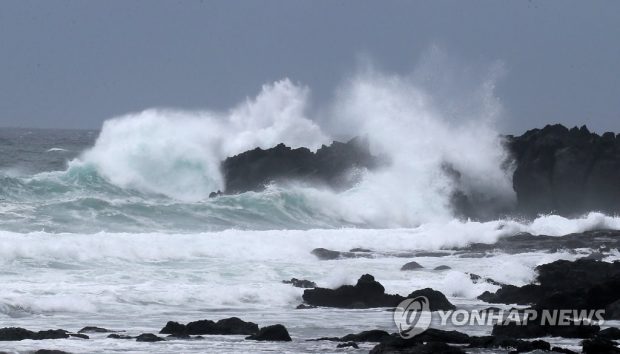Typhoon Lingling approaches South Korea

Strong waves crash on rocks off of Jeju Island on Sept. 6, 2019, as Typhoon Lingling approached. (Yonhap)
Seoul: A powerful typhoon is quickly moving northward to South Korea, with rain and strong winds seen on the country’s southern island of Jeju Friday.
Typhoon Lingling, this year’s 13th typhoon, passed over seas 330 kilometers southwest of Jeju at a speed of 43 kph as of 6 p.m., according to the Korea Meteorological Association.
Its central pressure was 950 hectopascals, and the maximum wind speed near its center was 43 meters per second, or 155 kph. Strong gusts like this can topple cars and ships and uproot trees.
The weather agency warned that the wind speed may peak at 55 meters per second, or 200 kph, in some island areas.
At the current speed, the typhoon is expected to reach seas 150 kilometers northwest of Jeju by 3 a.m. on Saturday and seas 110 kilometers west of Seoul by 3 p.m. the same day.
It is then forecast to hit the North Korean province of Hwanghae at 4 p.m. as it picks up speed, according to the weather agency.
South Korea is bracing for the powerful typhoon, with a preliminary typhoon warning issued across the country.
“Record-breaking winds will be seen at islands and southern and western coastal areas,” the weather agency said, advising local governments and residents to take precautionary measures.
A typhoon alert went into place across Jeju as of 6 p.m. The provincial government has suspended entrance to Mount Halla, the country’s highest mountain.
Jeju International Airport canceled all flights as of 8:45 p.m. All passenger ships operating between Jeju and other parts of the country were also suspended.
The central government and municipal governments across the country have implemented precautionary measures to minimize damage from the powerful storm.
The Ministry of Interior and Safety held a meeting at the Seoul government complex to discuss pan-government safety measures and raised the typhoon warning level by one notch.
President Moon Jae-in also visited the crisis control center under the National Security Council upon his return from a weeklong visit to Southeast Asian countries and ordered the government to fully prepare against typhoon damage.
Most municipal governments have suspended entrance to outdoor trekking routes and camping parks and rescheduled weekend events.
Port cities are especially taking caution with more than 300 cargo vessels evacuated in docks in Incheon, the country’s second-largest port city, just west of Seoul.
Typhoon Lingling is comparable to Typhoon Bolaven in 2012 in terms of its route and power.
Typhoon Bolaven’s maximum wind speed reached 51.8 meters per second, recording the sixth-strongest gust in the country since 1959. It killed at least 15 people and caused property damage of 636.5 billion won ($532 million).
YONHAP
























































